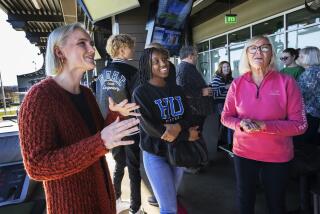‘Nice’ Pakistani, Suspect in CIA Slaying, Is Little Known : Crime: The 28-year-old immigrant is reported to have returned to his native country shortly after fatal shootings at the agency gates, then disappeared.
- Share via
WASHINGTON — He brought muffins to work on Mondays to share with his co-workers and never failed to blush when they thanked him. “He was so quiet, so nice, so courteous,” said his employer, Chris Marchetti, “that we’re all still trying to figure out how this guy could turn out to be a monster.”
Much remains unknown about Mir Aimil Kansi, the 28-year-old Pakistani immigrant who has emerged as the prime suspect in last month’s multiple shootings outside CIA headquarters in Langley, Va.
His motives--if he is the man who sprayed automatic weapons fire at passing cars on the morning of Jan. 25--remain as much of a mystery as where he is now.
He is reported to have returned to his native Pakistan shortly after the shooting, visited his family briefly, then disappeared. But Fairfax County police, who are handling the investigation with help from the FBI, the CIA and Interpol, caution that it would be a mistake to assume their suspect has fled the United States.
“We are investigating all avenues. Our search for him is worldwide. But no, we are not at all sure he is out of the country,” Fairfax County police spokesman Richard Perez said Thursday.
One crucial piece of the puzzle surrounding the shooting, in which two CIA employees were killed and two others severely wounded, was discovered Wednesday, when a brown compact station wagon matching the description of the killer’s was found parked in Herndon, Va., a few miles east of Reston, where Kansi lived.
Perez identified the car as a Datsun B210 that closely “resembles the vehicle described to us by witnesses” to the slayings. He said that it had been towed to a crime analysis center for examination and that the car’s owner had been notified and interviewed by police. He refused to identify the owner, however, or to say whether the owner knew Kansi or was otherwise involved in the case.
Although investigators refused to rule out the possibility of another suspect, the circumstantial case against Kansi appears to be strong.
Acting on a tip from Kansi’s roommate, police this week found two semiautomatic pistols, 550 rounds of ammunition, a bulletproof vest and a Chinese-made copy of an AK-47 assault rifle of the type used in the shootings in Kansi’s Reston apartment. They all had been purchased from a Virginia gun shop a few days before the shooting.
A fingerprint taken from a shell casing found at the scene of the shooting matched the prints in Kansi’s immigration records. Clothing that matched descriptions given by witnesses was found in the apartment, along with a pair of shoes containing small fragments of glass that could have come from the windshields that were shattered by gunfire.
Then there is Kansi’s disappearance the morning of the shooting. Marchetti, who owns the Herndon courier service where Kansi worked, recalls the day because it was the first time Kansi had failed to show up in the “five or six months” he had worked there.
“We tried to contact him on Monday but couldn’t,” Marchetti said. “Then on Tuesday, a day after the incident, he called us to apologize and say he had to go out of town unexpectedly, to North Carolina to attend to a sick cousin, and that he would be back in a few days.”
Kansi may have visited a relative, but in his hometown of Quetta in the southwestern Pakistani province of Baluchistan. Records show that a passenger with the last name of Kansi left Washington’s National Airport on Jan. 26 for New York to catch a connecting flight to Karachi. In a report from Quetta on Thursday, the Associated Press quoted members of Kansi’s family as saying that he arrived home shortly after the shooting but left again last Sunday, saying he was returning to the United States.
Just as elusive as Kansi is the motive for the shootings that killed intelligence analyst Lansing C. Bennett, 66, and Frank Darling, 28, an agency officer in the operations directorate.
Fairfax police spokesman Perez said that the investigation so far has failed to turn up even “one single piece of evidence” concerning the motive. But other sources said that the theory Kansi may have borne a grudge against the CIA is central to the investigation.
But perhaps the biggest mystery for Kansi’s co-workers and neighbors is how someone they knew and liked could have calmly walked up and down the Langley intersection, pumping round after round into the cars of motorists.
“He was a quiet man. He kept to himself. But he was always very nice, always very polite,” said a neighbor who requested anonymity.
“He was not the kind of guy anyone would ever suspect was a killer, but then a lot of times that turns out to be the case, doesn’t it? I mean, you read about these things and it turns out to be the polite, quiet ones who do it,” the neighbor added. “It’s the nice guys you got to watch out for.”
More to Read
Sign up for Essential California
The most important California stories and recommendations in your inbox every morning.
You may occasionally receive promotional content from the Los Angeles Times.










